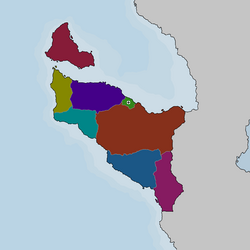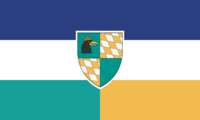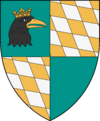Kisanaq
This article is incomplete because it is pending further input from participants, or it is a work-in-progress by one author. Please comment on this article's talk page to share your input, comments and questions. Note: To contribute to this article, you may need to seek help from the author(s) of this page. |
The Naquese Crown State Kisanaqa Tanala Hata (Naquese) | |
|---|---|
| Motto: God, Nation, Emperor | |
 Map of Kisanaq | |
 Kisanaq on the globe (green) | |
| Capital | Kisanaq City |
| Official languages | Kisanaq |
| Religion | Misakate |
| Demonym(s) | Kisanaq (noun) Kisanaq (adjective) |
| Government | Unitary parliamentary constitutional monarchy |
• Emperor | Ataraq Ki Maqi |
• Prime Minister | Adila Ki Faran |
| Population | |
• Estimate | 8,678,833 |
| GDP (nominal) | estimate |
• Total | |
• Per capita | |
| HDI | 0.978 very high |
| Currency | Kisanaq Anatak (KIA) |
| Driving side | right |
| Calling code | +101 |
Kisanaq, officially the Kingdom of Kisanaq Crown, is a country in northern Athenia, occupying the small Kisanaq Peninsula and the nearby Taraq Isle. Kisanaq is a constitutional monarchy and a developed country with an advanced high income market economy. Its capital and largest city, the Kisanaq City, serves as a financial centre of north Athenia and hosts the headquarters of many multinational corporations.
The country originates from the remote town of the Nbuka Realm, Kisanaq, which became home to the house of Rasmuq in 1203. In 1424, the house gathered enough resources and power to make the whole peninsula an autonomous region. The country, which at that time only contained the city and forests surrounding it, then gained full independence in 1497, after the collapse of the Nbuka Realm. Kisanaq was later colonized by Aftenheim in the 19th century and regained its independence in 1954.
History
Prehistory
Nbuka Realm
The tiny town of Kisanaq was established as a base for further expeditions into the wilderness of northern Athenian peaks. In the 1100s, it had a population of roughly a thousand people. In 1203, Adili of the house of Rasmuq made a deal with the Duke of the Northern Lands Misata Ki Afatikaq and had a castle by the name of Pataqi built northwest of the town, where he later moved with his wife Taqiha Ka Masapi and 2 sons. What followed were years of heavy investments into the town and its infrastructure, which resulted in the influx of peasants and the growth of the mostly fishing and hunting-based economy. In 1225, the coastal town was chosen to become the base for Nbukan northern sea expeditions. Kisanaq was given the status of a duchy in 1237, with the whole peninsula falling under Duke Adili Ki Rasmuq's rule, splitting away from the Nbukan province of the Northern Lands, ruled by Duke Paqa Ki Afatikaq.
First Kingdom
After the dissolution of the Nbuka Realm of 1497, the Duchy of Kisanaq formally transformed into a Kingdom, later called the First Kingdom of Kisanaq.
Aftenheimisch Colony
Kingdom of Kisanaq Crown
Government and Politics
Kisanaq is a unitary constitutional monarchy with a parliamentary system of government, wherein the Emperor of Kisanaq is the head of state and the prime minister is the head of government.
Head of state
The current serving head of state is Emperor Ataraq II. Ki Maqi, the eldest son of Adila IV. Ki Maqi, the former Naquese Emperor, and Kata VII. Ka Lakaraq, the Princess of Giha. In 2020, Ataraq's net worth was estimated around US$4 billion.
Federal subdivisions
Kisanaq is divided into 8 regions, with the capital of Kisanaq City acting as its own region.
Demographics
Ethnicity
Self-reported ethnic origin in the Kingdom of Kisanaq Crown
Language
Religion
Religious affiliations in the Kingdom of Kisanaq Crown
Education
Largest cities or towns in Kisanaq
Nataki Kisanaqi Statikaq | |||||||||
|---|---|---|---|---|---|---|---|---|---|
| Rank | Region | Pop. | |||||||
| 1 | Kisanaq City | Kisanaq City | 3,043,332 | ||||||
| 2 | Masina | Pakiniq | 377,440 | ||||||
| 3 | Nikakaq | Pakiniq | 294,200 | ||||||
| 4 | Giha | Taqisa | 102,562 | ||||||
| 5 | Hikana | Masa | 100,378 | ||||||
| 6 | Guqati | Taqisa | 93,409 | ||||||
| 7 | Hinaq | Taqisa | 81,754 | ||||||
| 8 | Nima | Pakiniq | 80,003 | ||||||
| 9 | Kisikaq | Katapa | 76,782 | ||||||
| 10 | Naqata | Masa | 63,612 | ||||||
Culture and Society
Education
Attitudes and worldview
Cuisine
Arts and Literature
Sports
Symbols
Economy and Infrastructure
Currency
Kisanaq Anatak

